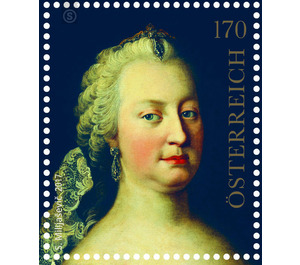300th birthday - Austria / II. Republic of Austria 2017 - 170 Euro Cent
Theme: History & Politics
| Country | Austria / II. Republic of Austria |
| Issue Date | 2017 |
| Face Value | 170.00 |
| Edition Issued | 120,000 |
| Printing Type | Offset / gold foil stamping |
| Stamp Type | Commemorative |
| Item Type | Stamp |
| Chronological Issue Number | 2678 |
| Chronological Chapter | OOS-OE2 |
| SID | 149099 |
| Dimensions | 36.00 x 30.00 |
| In 30 Wishlists | |
Maria Theresa, was undoubtedly one of the most influential women in the history of our country. On May 13, 1717, she was the daughter of Emperor Charles VI. born. In wise foresight he issued the Pragmatic Sanction, which stipulated the indivisibility of the Habsburg lands and the right of succession of female descendants. As Charles VI. In 1740, Maria Theresa, as his eldest daughter, took over the regency. Not all European princes, however, were in agreement, and so it came to the Austrian War of Succession. It was not until 1748 that Maria Theresia was recognized as ruler. However, she was unable to obtain the Roman-German imperial dignity. In 1745, her husband Franz Stephan of Lorraine was elected Emperor, therefore Maria Theresa is often referred to as Empress, although she was never formally. From this marriage, which founded the new line Habsburg-Lorraine, came out sixteen children, six of whom died during Maria Theresa's lifetime. The children were married according to power politics, in order to strengthen the house Austria and its relations to foreign countries. Accordingly, Maria Theresa is often called the mother-in-law of Europe. Maria Theresa's eldest son, Joseph II, became the Roman-German emperor and co-regent in Austria after the death of his father and was thus instrumental in many of his mother's reforms. Maria Theresa herself was very conservative, and her innovations sprang from the necessity and the enlightened ideas of her counselors rather than her own will to reform. Although their code of criminal law "Constitutio Criminalis Theresiana" was a regulation of the law, the abolition of torture took place only under Joseph II. It reformed and unified the administration of the individual countries, founded the military academy in Wiener Neustadt and implemented economic measures. One of their most famous reforms is certainly the introduction of compulsory education in 1774. And until today Maria Theresa's name is inextricably linked to one of the most famous buildings of our country: Castle Schönbrunn became the splendid imperial residence through her building measures, as we know her today. The special stamp block, which was issued as a joint edition with Slovenia, Croatia, Hungary and Ukraine, shows the portrait of Maria Theresa and the crown as a detail of her coat of arms.


